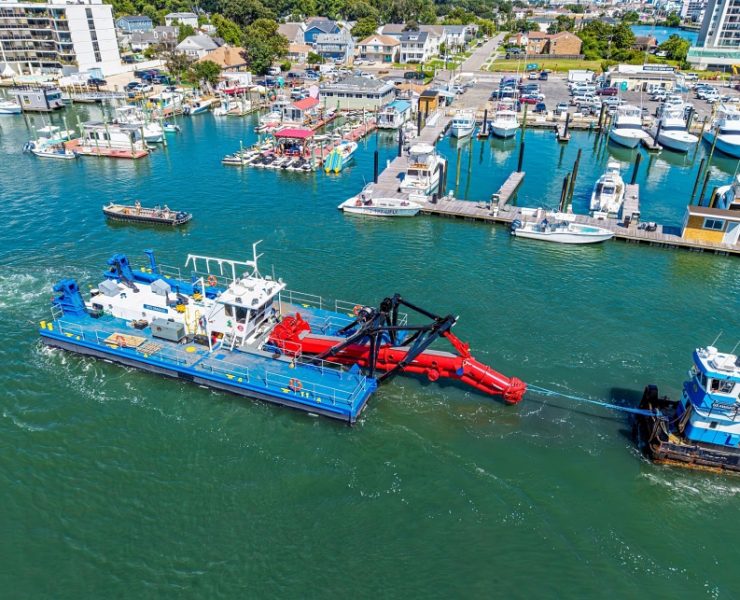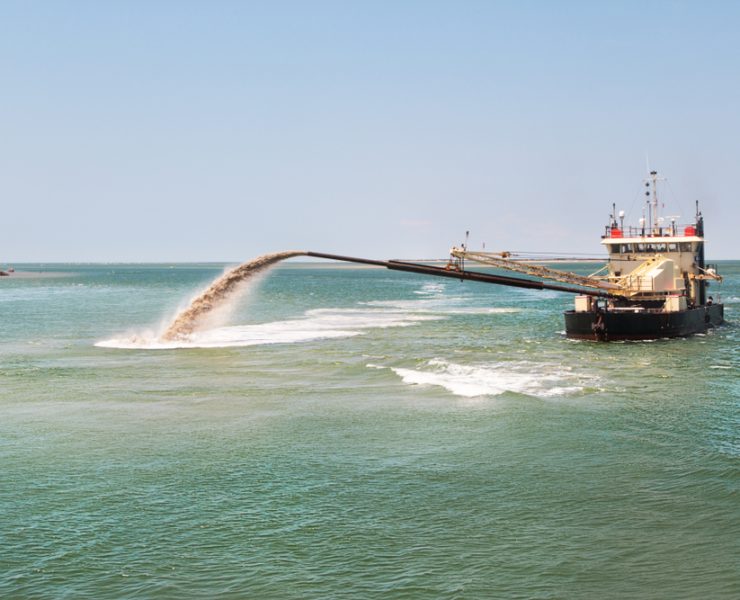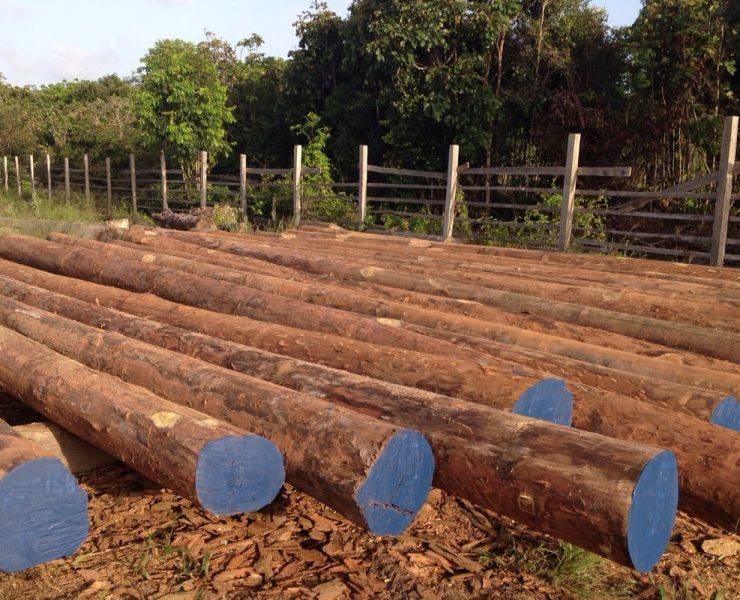Guidelines for Selecting a Marine Contractor

Contributed by New York Sea Grant
Most people who live or own a business on the water will, sooner or later, require the services of a marine contractor, either to construct or repair a dock, boathouse or ramp, or shoreline erosion control structure. Careful selection of a knowledgeable and reputable marine contractor to perform the work will often determine the quality and success of the project. It is critically important to choose an experienced contractor with expertise in the type of project that is proposed.
Differences Between Marine and Inland Construction
Marine construction is a specialized field dealing with the building, maintenance, and repair of structures in freshwater and marine coastal areas. These structures include erosion control projects such as bulkheads, seawalls, breakwaters, revetments, groins, jetties, artificial beach nourishment, coastal bluff reshaping and vegetative stabilization, as well as navigation projects such as docks, cribs, boat ramps and boathouses, marina basins and harbor projects, and dredging. This type of construction requires special, sophisticated equipment, such as barges, tugs, pumps and clamshell cranes, not used for general inland construction projects. Reputable marine contractors have this type of equipment, know how to operate it, and have experience putting it to use in diverse situations. Marine contractors can complete a shoreline construction project more efficiently and with greater assurance of quality control than could most inland contractors working in a coastal setting.

Construction in and along coastal waters is different from building in an inland location. The engineering and construction principles for land-based structures are not directly transferrable to coastal areas. The environment, physical forces, and often the soil types and morphology of coastal locations require specialized construction materials and techniques be used in marine construction compared with inland work. Knowledge of coastal processes such as waves, currents, and the transport of sediment particles is also important. It is possible that construction of an erosion control structure in one location could help alleviate the problem at that specific site, while causing a new problem in another, nearby location. For example, an improperly designed or placed bulkhead could solve an erosion problem by holding soil back and protecting it from wave attack while at the same time aggravating erosion along property adjacent to the structure by reflecting wave energy onto that unprotected site. To be successful in designing and building a coastal project, a marine contractor needs training and experience in coastal processes and marine construction techniques.
Marine contractors also need skill and experience at selecting the right building materials for coastal projects. For wooden docks and bulkheads, pressure-treated wood with certain minimum standards, is a necessity. A contractor should understand what type of preservative is needed and where to obtain suitably treated timbers. Different mixtures of concrete are required for coastal environments compared with dry-land settings. The use of an improper mixture could result in the structure deteriorating and failing long before it should, resulting in additional repair costs and, potentially creating a situation in which erosion may restart in the future. The selection of stone for a rock revetment is different than the selection of stone for an inland retaining wall. For example, although sandstone might work well for an inland wall, in a coastal environment it might prove to be too lightweight to withstand wave energies and will probably round out and move more easily than a denser, more angular dolomite. A marine contractor will know how to select the correct concrete or stone for a project.
Selecting a Marine Contractor
Most home or business owners would never hire a contractor to put a new roof on their home or build an addition to an existing place of business without first determining whether the contractor had ever performed such work before. Usually, the first contractor considered would not be hired unless the client was familiar with the contractor or knew a trusted someone who was.
Generally, several contractors would be considered and the best would be selected. Similarly, some preliminary research into marine contractors will ultimately help to ensure the success of a coastal project.

First, one should obtain and read educational materials concerning the type of marine construction project to be performed. One or several alternatives which could apply to the situation should be identified and design techniques based on proven engineering principles and construction practices for such projects should be studied. Publications addressing a variety of marine construction projects are available from Sea Grant and the U.S. Army Corps of Engineers. Next, write down as much as possible about what is intended to be accomplished by the project. The present situation should be outlined, the problem to be solved should be stated, and preferences for type of construction and final appearance should be described.
Potential contractors should be given as clear a picture of the project as can be provided, but should not have preconceived solutions presented to them; at this stage, they should be free to propose a range of feasible designs from which the client can chose a final project. Important information would include the exact location of the project, a description of the problem to be solved, rough estimates of the height and angle of any bluff, the width of any fronting beach, the general composition of shoreline sediments (i.e., sand, clay, cobbles), any restrictions that would preclude heavy machinery or barges from easy access to the construction site, and a rough description of what the client wants to accomplish.
Since the number of potential marine contractors in working in any given area is usually small, one of the easiest ways to obtain their names is to walk the shoreline. Existing projects solving similar problems should be inspected and discussed with the owners regarding the company that did the construction. Questions to ask include: did the contractor have the proper equipment to successfully complete the project; were there any unusual problems during or subsequent to construction; how long has the project been in existence; and, is the owner satisfied with the way it has performed. Some, but not all, marine contractors are in your local listings; others have web sites on the Internet.

After several companies have been identified that perform the sort of work being proposed, each should be contacted and provided with all the information previously compiled. Each should be invited to personally inspect the project site at separate times, with ample time being allowed for them to adequately review the project and present their company’s capabilities. Questions should be asked about price ranges for the various possible solutions, but the company representative’s should not be told at this point how much is budgeted for the project. A list of similar marine construction projects completed by the company should be requested; these projects should be visited if time allows and their owners are willing. Reputable contractors will usually submit preliminary design specifications along with a price estimate for your consideration shortly after the initial site visit.
After carefully reviewing the plans, noting any questions or uncertainties, ask the contractor to explain the rationale for the proposed designs or the use of certain materials. Remember, an improperly designed structure can fail prematurely and create an additional expense in the future; it may even result in additional erosion at the site of the structure or at an adjacent site. Answers to these questions can provide useful insight into the contractor’s training, experience, and knowledge of coastal construction. For example, if a design calls for the use of filter cloth, the contractor could be asked why. If a rock revetment is proposed, the contractor could be asked why a particular size and type of stone has been selected. If answers to questions such as these sound ambiguous or lack credibility, serious consideration ought to be given to selecting another company for the project. This is when the information learned from coastal erosion control publications studied beforehand can be most valuable a quick check will show whether there is something lacking or different between accepted design techniques and those proposed by the marine contractor. Be sure to discuss the entire scope and cost of the project and the anticipated time schedule.

With regard to the price estimate, the contractor should fully explain what the estimate is based upon. An alternative would be to have the project designed by a professional engineer and let several contractors submit bids based on those specifications. Although this would be more costly, it would assure that all estimates are figured on the same design.
Finally, the contractor that is determined to have the greatest capabilities for completing the project in an acceptable manner should be selected. The decision should take into account the contractor’s experience, reputation, special qualifications, personnel available, time schedule, and grasp of the project and any related problems. Do not automatically hire the company that gives the lowest estimate. Instead, look at the materials proposed for use, the design specifications, and the quality of service being offered. A poorly designed/constructed structure could require repair sooner than a better, more expensive project, resulting in greater long term costs. The details should be in a written contract for signature by both the client and the contractor. Although this process requires extra time and effort, future rebuilding or repair costs may be reduced substantially.
Permits for Coastal Construction Projects
Many projects involving the placement of fill or permanent structures along the shore, or disturbance of the shore or bed of a body of water, require permits from the New York State Department of Environmental Conservation (DEC), the U.S. Army Corps of Engineers, and possibly local jurisdictions, as well. Readers are advised to contact the nearest office of DEC or the Corps to determine what state and/or federal permits might be necessary; town or village codes enforcement offices should be able to identify local permit requirements.
General tips when shopping for a marine contractor:
• Don’t shop on price alone. The cheapest contractors may not be the best contractors, and the least expensive project may not be the most effective project.
• Insist on good workmanship, including good on-site housekeeping.
• Know what you want ahead of time. Try to eliminate expensive midstream changes which can cause major problems.
• Make access and working conditions as easy as possible for the contractor.
• Understand the cost and scheduling impact of any additional work recommended by the contractor.• Don’t do business with a contractor who doesn’t make safety a priority.
Glossary of Coastal Structure Terms
Accretion The buildup of a beach by actions either of nature (such as deposition of sand by wind or waves) or of humans (mechanical deposition of beach fill or trapping of sand behind a groin or jetty).
Artificial beach nourishment The process of replenishing a beach (usually sand) from another location by mechanical means.
Breakwater A structure built either offshore from an eroding shoreline or connected to that shoreline, extending out into the water, to protect the shore from wave action, or to provide calm water for boat mooring or docking, when used to protect a harbor, basin or anchorage.
Bulkhead A structure or partition built to retain land and prevent it from sliding into a body of water. Bulkheads also protect the land behind them from direct attack by waves.
Coastal erosion The loss or displacement of land by the action of waves, currents, tides, waterborne ice, or impacts of storms; or the direct action of wind, runoff of surface water, or groundwater seepage on a coastal bluff or beach.
Filter cloth A special construction material, woven of modern synthetic fibers or compressed from synthetic or natural fibers, which is used extensively in marine construction behind and/or underneath erosion control structures. It is permeable enough to allow water to pass through, but impermeable enough that soil is prevented from being carried through the erosion control structure, causing the structure to become unstable and settle.
Flanking Erosion at and around the outward ends of land-connected shore-protection projects or other hardened portions of the shoreline. When not stopped or controlled, flanking can result in the failure of shore protection devices.
Groin A coastal erosion control structure usually built perpendicular to the shoreline to trap and hold littoral drift and slow the erosion of the shore. Groins can also be used to promote beach accretion.
Jetty A structure extending into a body of water for the purpose of directing and confining river or tidal flow into a channel and preventing or reducing shoaling of the channel by littoral material.
Littoral drift (a.k.a. longshore drift) The sediment (usually sand) moved along the shore in the nearshore zone by waves and currents.
Pile A long heavy timber or piece of metal, wood or concrete driven or jetted into the ground to serve as a support for or part of a coastal erosion control structure, dock, pier or jetty.
Recession The net landward movement or retreat of coastal bluffs and beaches over time due to erosion. Long- and short-term recession rates are usually expressed as feet or meters per year.
Revetment A facing of stone, concrete, and the like, built to protect a bluff, beach, embankment or structure from erosion by wave action or currents.
Riprap A facing of stones, randomly placed, to prevent erosion or scouring. May also refer to the stone used for such a layer.
Seawall A coastal erosion control structure built to separate the land from the water and to prevent damage from wave attack. A secondary purpose is to retain the land behind the structure.
Specifications A detailed description of construction project particulars, such as size of stone, quality and quantify of materials, contractor performance, terms and quality control.
Toe erosion The erosion that occurs at the lowest point of the front slope of bluffs at the water’s edge, largely as a result of the continuous removal of earthen materials by waves, tides or currents.
Coastal erosion processes and control information is available from:
New York Sea Grant – 146 Suffolk Hall – Stony Brook University – Stony Brook, NY 11794-5000 – 631.632.8730 or – Great Lakes Coastal Processes Specialist at 607.255.2832
631.632.8730
What is the significance of choosing a marine contractor with expertise in coastal projects?
Selecting a marine contractor experienced in coastal construction ensures specialized knowledge of environmental factors, coastal processes, and the use of suitable materials for successful and enduring marine projects.
What considerations are crucial when selecting a marine contractor for a project?
Important considerations include researching potential contractors, outlining project details, inviting on-site inspections, understanding proposed designs and materials, and assessing the contractor's experience, reputation, and qualifications.


















